Just across the river from Lisbon lies an old fishing village that is now a foodie hotspot and home of an iconic monument.
A Short History
This area, now known as Almada, has fertile land and a rich river full of fish, so humans have inhabited the area for at least 5,000 years, though nomadic tribes regularly moved through, exploiting the sea for its bounty.
When the Phoenicians expanded past the eastern Mediterranean, they too found Almada a bountiful place and established a settlement in the 8th century BCE. Later, the Romans conquered most of the Iberian Peninsula and used Almada for fishing and fish processing.
The Moors took over in the 8th century CE and built a fort on a strategic high point where they could monitor the river traffic for many miles, giving them the jump on any potential attacks.
In 1147, the army of Portuguese king Alfonso I defeated the Moors in Almada. The Moorish fort was greatly expanded, creating the Almada Castle.
For generations, Almada was a sleepy fishing village but more recently the city has become a bedroom community for workers in Lisbon who take advantage of easy access to the Portuguese capital by the ferry that only takes about 15 minutes to cross the river.

Foodie Almada
Traditional Portuguese Food
Just like any town in Portugal, there’s tons of little taverns and cafes serving traditional Portuguese fare to locals. Almada doesn’t boast a singular dish that it is most identified with. But, due to its prime location on the Tagus River, fresh seafood is a specialty.
My favorite spot for traditional Portuguese dining is O Antonio. The menu is mostly meat and seafood, but they do have a couple veggies on the menu.
For me, I love the casual atmosphere. They have a couple desserts in the display case and I really love the chocolate pudding. I wasn’t expecting much when I got it the first time, I just wanted a quick snack, but I was shocked at how good it was. Incredibly rich and decadent, it was perfect with a glass of the house red wine, which is served from a box, BTW.
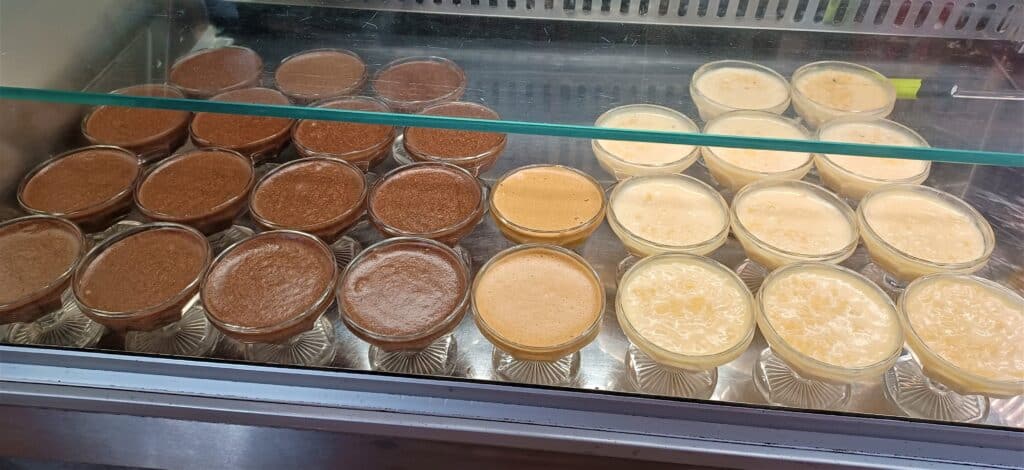
Veggie Almada
Vegetarians may struggle to find suitable dishes and as of this writing there is no dedicated vegetarian restaurant in Almada. Yet, hope springs eternal. When eating in Almada, plant-based diners may find that Indian, Nepali, and Middle-Eastern restaurants are their best option.
Damasqino is an incredible Syrian restaurant that just opened in 2022. The food is super flavorful with the stuffed grape leaves topped with a pomegranate reduction and the Muhammara being my favorites.
The veg. dishes are clearly labeled on the menu and there’s lots of plant-based options.
The pita is baked fresh all day. Step inside and watch the bread puff up in the open oven. There’s also a patio where you can eat outside. Highly recommended!
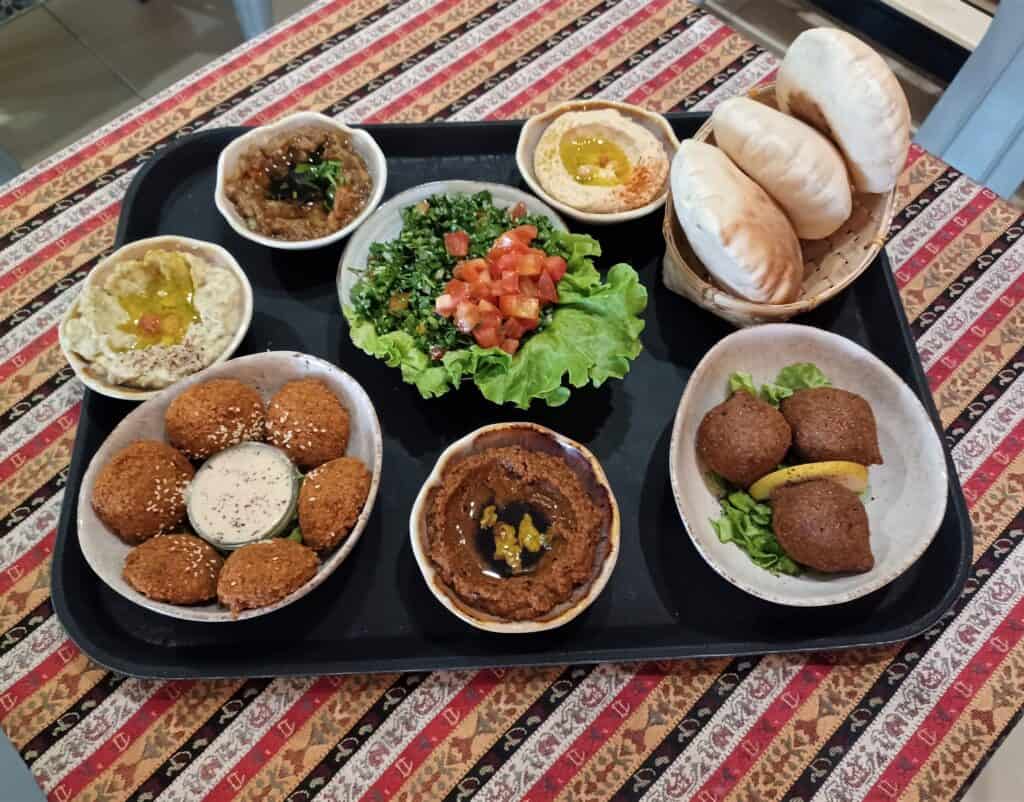
Dining with a view
Amarra O Tejo
Yes, Ponto Final gets all the love, but my favorite views are definitely at Amarra O Tejo. It takes a bit of work to get there (take the Boca do Vento Elevator to save some climbing), but once you arrive you’ll understand why I recommend this place.
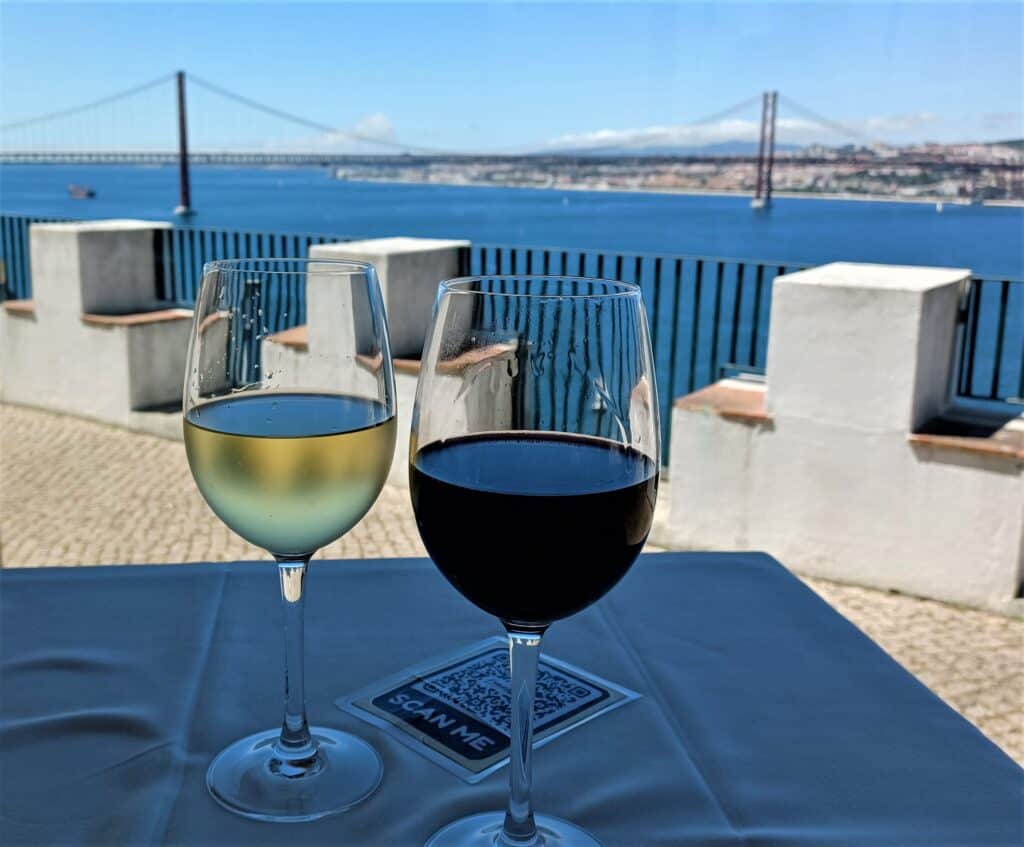
The food is very good and there are a couple of veg. options (though no main courses) on the menu. I love the goat cheese and nuts wrapped in a puff pastry.

If you don’t want to dine, you can order a drink from the restaurants cool take-out window and sit on the one of the built-in cement seats on the miradouro (view point) and enjoy the spectacular scenery from the April 25th Bridge all the way to Alfama and beyond!
Ponto Final
Ponto Final is far and away the #1 restaurant in Almada.

Much is its popularity is thanks to the show “Somebody Feed Phil.” In a Season 1 episode in Lisbon, Phil rides across the river and eats at Ponto Final. His raves have translated into huge success for the restaurant.
Reservations must be made weeks in advance, so plan ahead.
With views like these, you can see why it’s so popular. Luckily, the food lives up to the hype. Nearly everyone gets the fresh seafood but I’m partial to their tempura green beans and tomato rice. The house brined olives are also great and they have a good wine list.
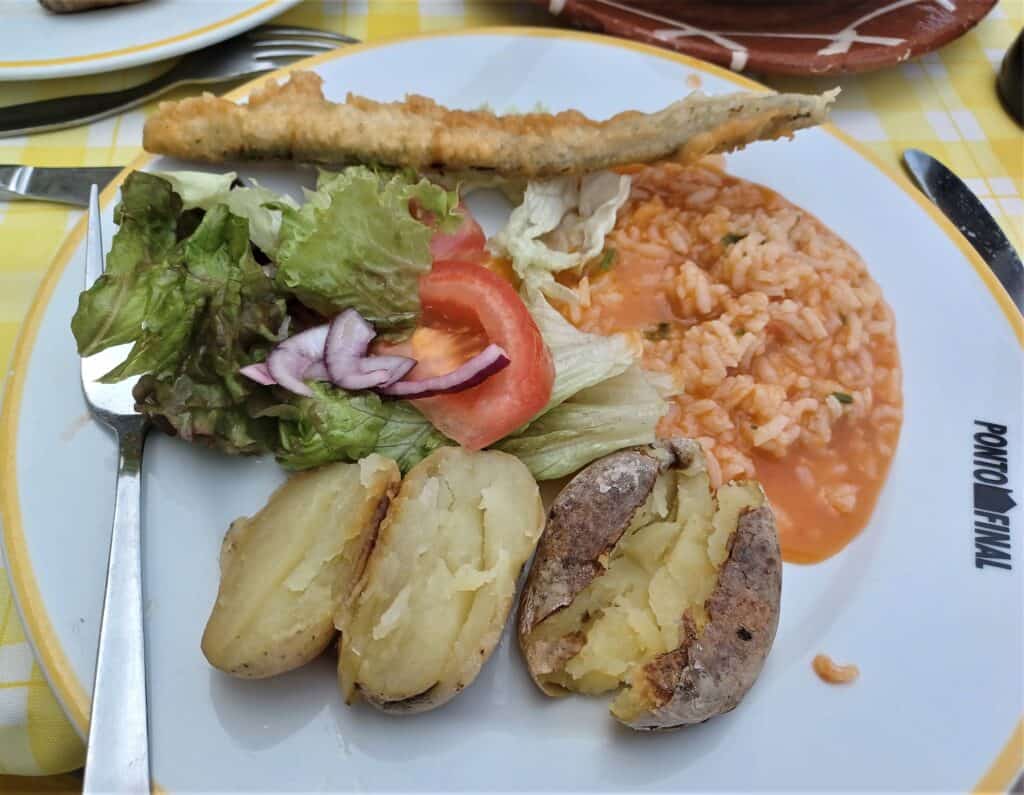
Atira-te Ao Rio
Right next to Ponto Final is Atira-te Ao Rio. They also have seating right on the water with equally amazing views. You might think that since Ponto Final is so overwhelmingly popular that you could walk up and get a set at Atira-te Ao Rio. You’d be wrong.
Atira-te Ao Rio is equally busy and reservations are a must.
Pastry
Apparently, there was/is a dish from Almada called Almana (or is it Al Mana)? There was even a restaurant (or was it a bakery?) called Almana. But, when I went there, it was long gone.
No one seems to know what an Almana is, and those that have heard of it can’t tell me a place that makes it or sells it. In fact, no one who I talked to in Almada had ever tasted it! The Internet is no help either, so, for now, the search continues, though I don’t currently have any leads.
That said, there are some very nice pastelarias (bakeries) in Almada. My favorites are in downtown area, not the riverfront. You can walk to even the furthest one in less than half an hour, or, better yet, if you’re walking back from the Cristo Rei, stop at one or two before heading back to the ferry
Pastelaria Repuxo
A Fabrico Proprio (house made) bakery and cafe, just a 10 minute walk from the ferry terminal. They have a large selection of delicious pastry. I get a treat and some fresh squeezed orange juice and I’m ready for the day! Repuxo is also a busy cafe, offering a menu of the day to hungry diners with a fish or meat dish (no vegetarian option).

Pastelaria Golfinho
Translating to the Dolphin Bakery, this super casual and fun spot is where locals and tourists hang. I was so delighted to see hard boiled eggs in the display case that I ordered one with my coffee. After all, what could be more traditional than eggs and coffee for breakfast?

Pastelaria Pascoa
Pastelaria Pascoa has been around since 1956. They expanded to their huge space in 1981 and make everything in house. You’ll be hard-pressed to decide what to get, so ask the helpful staff and they’re sure to steer you in the right direction.

Things to do in Almada
Cristo Rei
The Cristo Rei monument, by far the most popular attraction in Alamada, sits atop Almada overlooking the Tagus River and Lisbon. Clearly visible from many spots in Lisbon, Cristo Rei has become the symbol of Almada.
If Cristo Rei looks similar to Rio’s Christ the Redeemer statue, there’s a good reason for that. In 1934, Lisbon Cardinal Patriarch visiting Rio and the Christ the Redeemer site which had just been dedicated 3 years earlier.
The Cardinal returned to Lisbon and was so inspired by the site, he pushed for a massive Jesus statue in Lisbon. It took until 1941 for the land in Almada for the statue and sanctuary to be acquired and it wasn’t until 1949 that the cornerstone was laid. The entire project was said to give thanks to God for keeping Portugal from the worst ravages of WWII (Portugal was officially neutral in the war). However, it should be noted that during this time Portugal was undergoing its own problems. The government was overthrown by a fascist regime in 1933 that spent the next 40 years kidnapping, torturing, and murdering anyone they suspected of being a political opponent.
Cristo Rei was completed in 1959 and dedicated on May 17th of that year. It is estimated that 300,000 people attended the dedication and having been to the site, I don’t know where they fit them all.

The site already holds a commanding position on a hilltop over the river. On top of that is the statue’s platform which is 269 feet tall. On top of the platform is the statue, itself 92 feet high.
The Cristo Rei statue is surrounded by a park with a promenade overlooking the river. From here you can get incredible views of Lisbon and the nearby April 25th Bridge which carries car and train traffic between the city and the Setubal Peninsula.
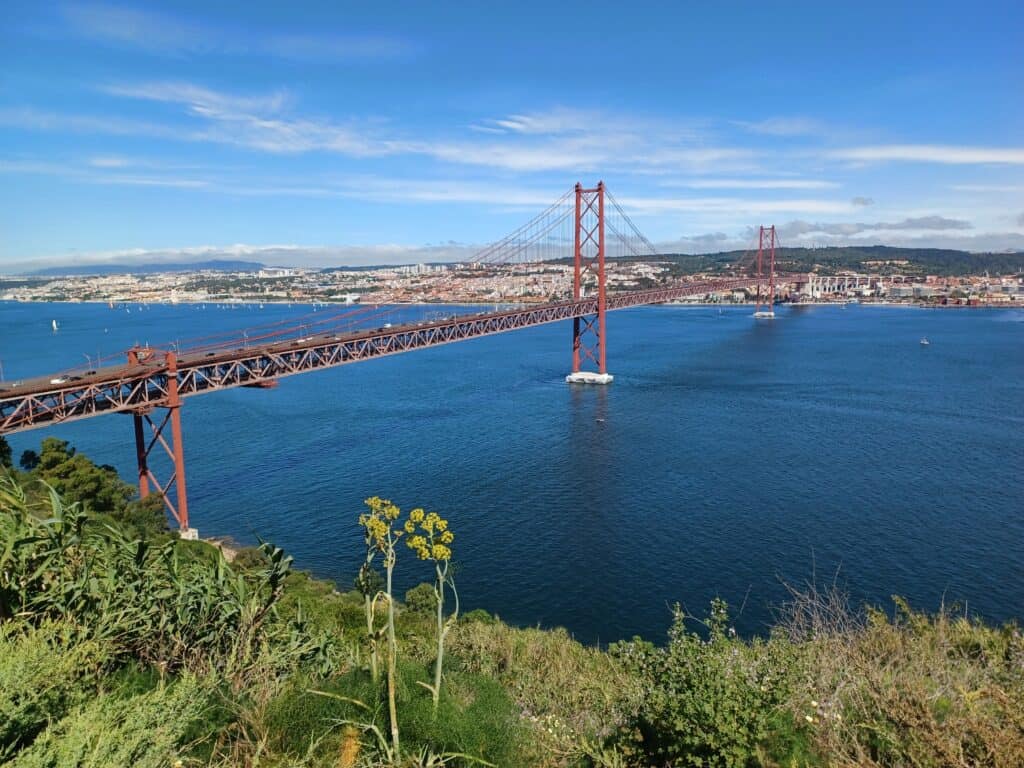
For a few euros you can take an elevator and climb a couple flights of stairs to the outdoor platform deck at the feet of the Jesus statue. It’s from there that you’ll enjoy an even better view!
Getting to Cristo Rei
If you’re coming from Lisbon, take the ferry from Cais do Sodre to Cacilhas (Alamada). The ferry terminal is next to the transportation hub where you can take bus 3001 to Cristo Rei.
You can also walk from the ferry terminal to Cristo Rei. If you ask Google, the route will likely take you up through the uninteresting residential part of Almada. However, there’s a much more enjoyable path.
Walk along the river towards the April 25th Bridge. You’ll pass by Ponto Final (hopefully you have reservations for later), some interesting street art (and lots of tagging) on the abandoned fish canneries and warehouses, and Quinta da Arealva, an abandoned winery (see below).
It is important to point out that the buildings at Quinta da Arealva are falling down and are unsafe to climb on. Ceilings have collapsed in most buildings and other pieces of rock or cement could come loose and hurt you. Also, the concrete has many holes in the floor so keep your eyes open so you don’t fall. This place would be quite dangerous at night or in low light conditions.
Continue past Quinta Arealva and up a closed road to Cristo Rei. The whole walk takes about 45 minutes if you don’t stop along the way, but there’s so many great view points and interesting crumbling buildings that you’ll definitely be taking longer as you pause to admire the scenery.
Note that this path is very uneven in spots and those with mobility issues should not attempt.
Quinta da Arealva
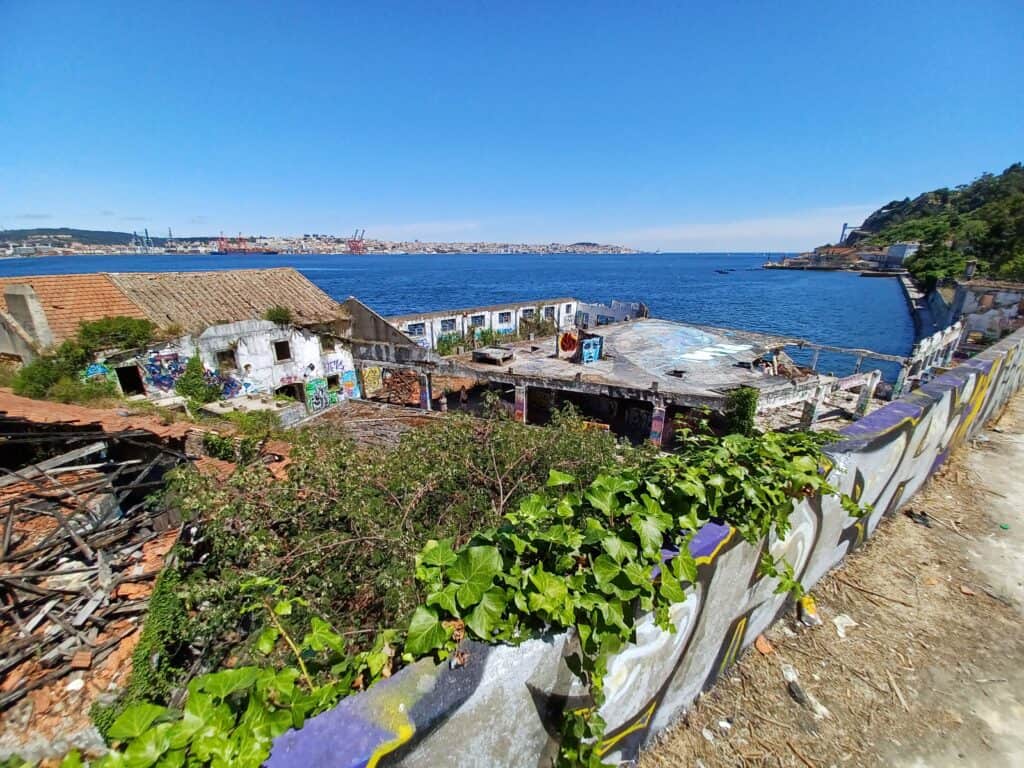
Trade along the Tagus River has always been an important part of the economy of Lisbon. Several outposts, used by the military, were built along the river to control maritime traffic. One of those structures was built here at what eventually became Quinta da Arealva. When the military abandoned the area in the 18th century, things got interesting from a culinary point of view.
New owners from the local area secured the property and built several new structures to support the new wine making business including warehouses and a cooperage. After all, if you’re going to be producing wine, you’re going to need wine barrels; why not make them right on the premises?
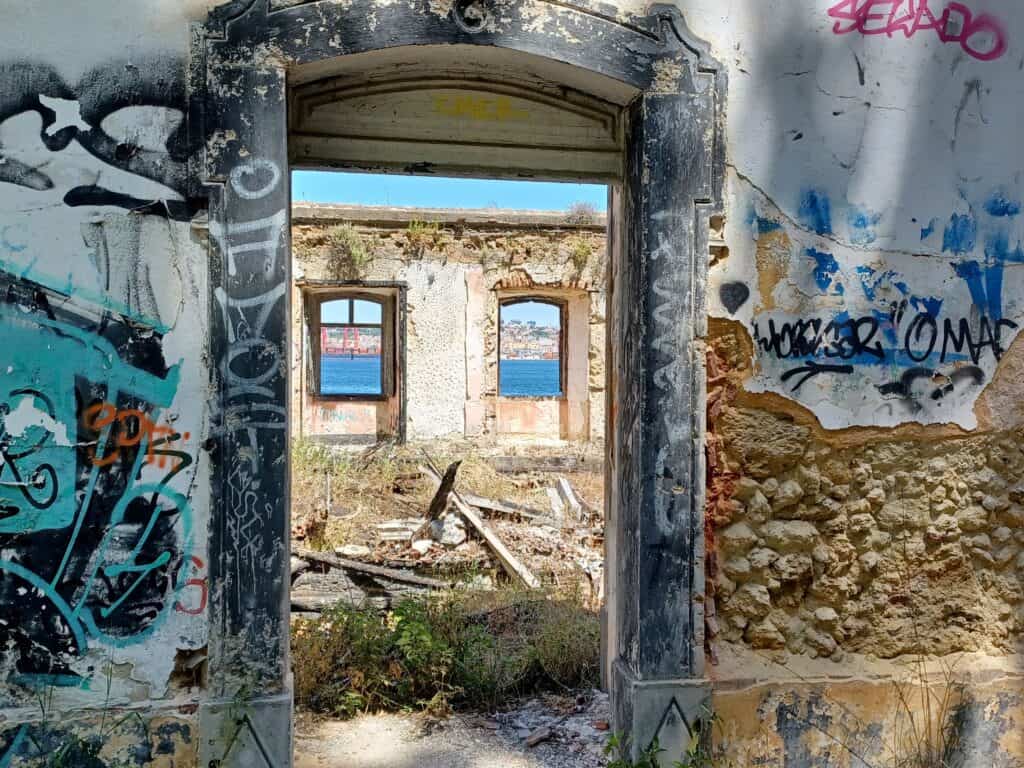
The Quinta da Arealva was difficult to access by land, but the river provided a way to easily ship the wineries’ product to Lisbon, the rest of Portugal, and beyond.
Later, after the winery was abandoned and left to rot, it was vandalized and set on fire. In the last 25 years there have been attempts to revamp the property. A few festival concerts were held here in the 2010s and the local government, with the current landowner, claims they’d like to make Quinta da Arealva part of a heritage trail, which I think is a great idea.
Today, the buildings are crumbling. However, street artists have started to use the walls of the abandoned buildings as canvases for their work. Dozens of murals are on the walls and this artwork is, in general, far more interesting that those on the more famous Rua do Ginjal.

This is also an amazing spot to watch the sunset. Exercise caution, because after dark, the trip and falling hazards become that much more dangerous.
Getting to Quinta da Arealva
A great way to see Quinta da Arealva is to make it part of a walk from the ferry dock at Cacilhas to Cristo Rei. On this route you’ll walk past the street art (tagging mostly, unfortunately) of Rua do Ginjal decorating the abandoned warehouses along the river and the famous Ponto Final and Atira-te ao Rio.restaurants. As I said above, the buildings at Quinta da Arealva are falling down and much of the area is unsafe. Be sure to exercise caution when visiting.
Boca do Vento Elevator
Not only is this a super convenient way to save walking up the steep hills to the upper part of Almada, riding in the elevator reveals amazing views of the Tagus River and Lisbon. Best of all, it’s free!
At the bottom, there’s a tiny park this is a nice for a little picnic, though it can get crowded, especially on weekends.
Quinta do Almaraz
700 years before the Romans arrived in Almada, the Phoenicians created a settlement here. They exploited the Tagus river’s abundant fish population and tilled the fertile ground.
In 1986, on a bluff overlooking Lisbon and the Setubal Peninsula, a Phoenician settlement was discovered. Since then, archaeologists have uncovered ceramics as well as copper and iron artifacts leading researchers to wonder if Quinta do Almaraz was a metal producing center.
To visit the site you must make an appointment by emailing arqueologia@cma.m-almada.pt.
Almada Castle
Next to the Quinta do Almaraz is the Castle of Almada. Originally built by the Moors because of its prime location overlooking the river, the fort was greatly expanded to a castle after the Reconquista in the 12th century CE and in the centuries that followed until it was decommissioned in 1825.
However, just 6 short years later, the castle was again put to use during the Portuguese Civil War.
In the early 1930’s, Portugal’s political system and economy were in chaos as fascists and republicans fought for governing power. On August 26th, 1931, revolutionary airman José Manuel Sarmento de Beires flew from an air base north of Lisbon with the intent of bombing the castle. He missed the target and his bomb instead fell in the town square, killing 3 people and injuring many others including children. The site is now known as Largo das Vítimas de 26 Agosto (Victims of the 26th of August Square).
While you can see the imposing castle walls, entry is not allowed as the space is used as offices for the Portuguese National Guard (GNR).
Transportation
Most people come to Almada for a day trip from Lisbon. The best way to get to the city is to take the ferry from Cais do Sodre in Lisbon to Cacilhas.
The ferry terminal is part of a transportation hub in Cacilhas that includes a bus terminal and light rail line. Bus 3001 will take you up to Cristo Rei, though I suggest a nice walk of 45 minutes if you have the time (see above).
The light rail has connections to the Pragal and Corroios stations where there is train service to Lisbon (via the April 25th Bridge) to the north and Setubal to the south.
Index of Things to do in Almada
Cristo Rei
Inspired by Rio’s Christ the Redeemer, this statue overlooks the river to Lisbon.
Av. do Cristo Rei, 2800-058 Almada, Portugal
Quinta da Arealva
Abandoned winery.
Boca do Vento Elevator
Elevator takes you from the lower to upper part of town. Spectacular views. Tiny park at the lower stop.
Quinta do Almaraz
Archaeological site dating back 2,800 years to Phoenician times. Visits by appointment.
Travessa do Castelo, Almada, Portugal
Castle Garden
Nice viewpoint.
Largo 1º de Maio, 2800-246 Almada, Portugal
Castle of Almada
Castle first built by the Moors, now offices for the National Guard (GNR)
Alameda do Castelo, 2800-108 Almada, Portugal
Frigate Dom Fernando II e Glória Museum
19th century restored wooden-hulled frigate is now a museum.
Lgo Alfredo Dinis, 2800-252 Almada
Index of Food & Drink in Almada
Ponto Final
Waterfront restaurant made famous by “Somebody Feed Phil.”
R. do Ginjal 72, 2800-285 Almada, Portugal
Amarra O Tejo
Fine dining with the best views in Almada.
Largo 1º de Maio 2, 2800-120 Almada, Portugal
Atira-te Ao Rio
Waterfront dining next to Ponto Final.
R. do Ginjal 69, 2800-284 Almada, Portugal
Damasqino
Amazing Syrian food.
R. Cmte. António Feio 28A, 2800-255 Almada, Portugal
A Taverna O Antonio
Old school Portuguese Taverna.
R. Latino Coelho 1A, 2800-202 Almada, Portugal
Pastelaria Repuxo
Top notch bakery and cafe.
Praça Gil Vicente 3, Almada, Portugal
Pastelaria Golfinho
Characteristic bakery in Almada.
R. Cap. Leitão 10, 2800-132 Almada, Portugal
Pastelaria Pascoa
Excellent bakery.
a 32A, Av. Dom Nuno Álvares Pereira 28, Almada, Portugal
Annapurna
Nepali restaurant with a dedicated vegetarian menu.
Av. Dom Nuno Álvares Pereira 10, 2800-201 Almada, Portugal
Index of Shopping in Almada
Mercado Municipal de Almada
Indoor produce market.
Pç do Comércio 5, 2800-051 Almada, Portugal
Garrafeira de Almada
Place to pick up a bottle for a picnic.
Av. Prof. Egas Moniz 2, 2800-088 Almada, Portugal
Sabores de Monsanto
Gourmet grocery store and wine shop.
R. Cmte. António Feio 45 B, 2800-561 Almada, Portugal
Index of Places to Stay in Almada
Cacilhas Guest Apartments
Cute apartments near the ferry and eating establishments.
R. Cândido dos Reis 102, 2800-600 Almada, Portugal
About the Author

Brent Petersen is the Editor-in-Chief of Destination Eat Drink. He currently resides in Setubal, Portugal. Brent has written the novel “Truffle Hunt” (Eckhartz Press) and the short story collection “That Bird.” He’s also written dozens of foodie travel guides to cities around the world on Destination Eat Drink, including in-depth eating and drinking guides in Portugal to Lisbon, Porto, Monsaraz, Sintra, and Batalha. Brent’s podcast, also called Destination Eat Drink, is available on all major podcasting platforms and is distributed by the Radio Misfits Podcast Network.
